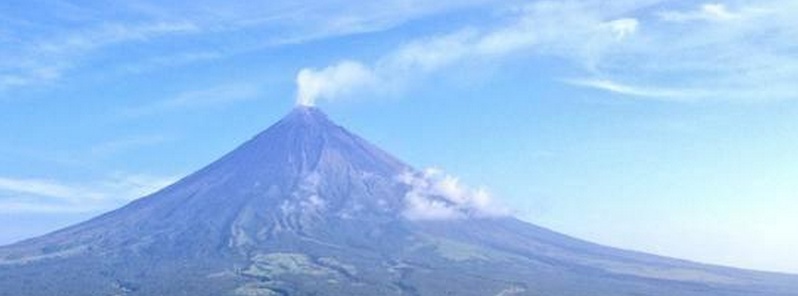A new eruption may soon take place at Mayon Volcano, Philippines

Fresh lava flow observed this morning at Mayon Volcano has raised concerns a new eruption may soon take place, PHIVOLCS said on Sunday, October 12, 2014.
The activity at the volcano suddenly increased on September 15 and lasted for a few days.
"After that, there was a lull or no summit activity, but this morning, our volcanologists spotted a lava flow," head of PHIVOLCS, Renato Solidum, told ABS-CBN television. "What is happening now is that there is very slow movement… of lava flow about 350 meters (1 148 feet) in length from the summit," he added.
Solidum warned lava flow from Mayon was usually followed by "an explosive phase of eruption" although he could not estimate when such blasts could occur.
He explained magma inside the volcano was now rising to the summit slowly but added that it could accelerate, prompting quakes and small explosions and potentially causing a much larger eruption.
Around 63 000 people living within a six-kilometer danger zone around the volcano have been evacuated since September 15.
In a latest Mayon Volcano bulletin issued October 12, 2014, PHIVOLCS said their seismic network recorded four (4) volcanic earthquakes and one (1) rockfall events during the past 24-hour observation period.
"Moderate emission of white steam plumes drifting north-northeast and northwest was observed. No crater glow was observed last night.
Sulfur dioxide (SO2) flux was measured at an average of 206 tonnes/day on October 10, 2014. Ground deformation data showed continuous inflation at the base of the edifice from August 2014 to October 2014 precise leveling surveys. The edifice remains inflated compared to baseline measurements.
Tilt data also indicate continuous inflation at the base of the edifice since August 2014. All the above data indicate that the volcano is still in a state of unrest due to the movement of potentially eruptible magma.
Mayon Volcano’s alert status remains at Alert Level 3. This means that magma is at the crater and that hazardous eruption is possible within weeks. It is recommended that the 6-km radius Permanent Danger Zone (PDZ) around the volcano and the 7-km Extended Danger Zone (EDZ) on the southeastern flank be enforced due to the danger of rock falls, landslides and sudden explosions or dome collapse that may generate hazardous volcanic flows."
Erosion gulleys & drainage channels in the southern slope of #Mayon radiating from its summit via Christian Calleja pic.twitter.com/sxuzwOM9Iz
— jaime s. sincioco (@jaimessincioco) October 7, 2014
Geologic summary
Beautifully symmetrical Mayon volcano, which rises to 2462 m above the Albay Gulf, is the Philippines' most active volcano. The structurally simple volcano has steep upper slopes averaging 35-40 degrees that are capped by a small summit crater. Historical eruptions at this basaltic-andesitic volcano date back to 1616 and range from strombolian to basaltic plinian, with cyclical activity beginning with basaltic eruptions, followed by longer term andesitic lava flows.
Eruptions occur predominately from the central conduit and have also produced lava flows that travel far down the flanks. Pyroclastic flows and mudflows have commonly swept down many of the approximately 40 ravines that radiate from the summit and have often devastated populated lowland areas.
Mayon's most violent eruption, in 1814, killed more than 1200 people and devastated several towns. (GVP)
Featured image: Mayon Volcano (Jaime S. Sincioco via Christian Calleja / Twitter)

Commenting rules and guidelines
We value the thoughts and opinions of our readers and welcome healthy discussions on our website. In order to maintain a respectful and positive community, we ask that all commenters follow these rules:
We reserve the right to remove any comments that violate these rules. By commenting on our website, you agree to abide by these guidelines. Thank you for helping to create a positive and welcoming environment for all.